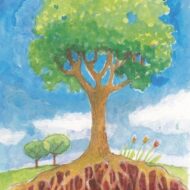Can You Become a Creature of New Habits?
By JANET RAE-DUPREE
 Rather than dismissing ourselves as unchangeable creatures of habit, we can instead direct our own change by consciously developing new habits. In fact, the more new things we try — the more we step outside our comfort zone — the more inherently creative we become, both in the workplace and in our personal lives.
Rather than dismissing ourselves as unchangeable creatures of habit, we can instead direct our own change by consciously developing new habits. In fact, the more new things we try — the more we step outside our comfort zone — the more inherently creative we become, both in the workplace and in our personal lives.
Brain researchers have discovered that when we consciously develop new habits, we create parallel synaptic paths, and even entirely new brain cells, that can jump our trains of thought onto new, innovative tracks.
But don’t bother trying to kill off old habits; once those ruts of procedure are worn into the hippocampus, they’re there to stay. Instead, the new habits we deliberately ingrain into ourselves create parallel pathways that can bypass those old roads.
“The first thing needed for innovation is a fascination with wonder,” says Dawna Markova, author of “The Open Mind” and an executive change consultant for Professional Thinking Partners. “But we are taught instead to ‘decide,’ just as our president calls himself ‘the Decider.’ ” She adds, however, that “to decide is to kill off all possibilities but one. A good innovational thinker is always exploring the many other possibilities.”
Researchers in the late 1960s discovered that humans are born with the capacity to approach challenges in four primary ways: analytically, procedurally, relationally (or collaboratively) and innovatively. At puberty, however, the brain shuts down half of that capacity, preserving only those modes of thought that have seemed most valuable during the first decade or so of life.
This is where developing new habits comes in. If you’re an analytical or procedural thinker, you learn in different ways than someone who is inherently innovative or collaborative. Figure out what has worked for you when you’ve learned in the past, and you can draw your own map for developing additional skills and behaviors for the future.
“I apprentice myself to someone when I want to learn something new or develop a new habit,” Ms. Ryan says. “Other people read a book about it or take a course. If you have a pathway to learning, use it because that’s going to be easier than creating an entirely new pathway in your brain.”
“Whenever we initiate change, even a positive one, we activate fear in our emotional brain,” Ms. Ryan notes in her book. “If the fear is big enough, the fight-or-flight response will go off and we’ll run from what we’re trying to do. The small steps in kaizen don’t set off fight or flight, but rather keep us in the thinking brain, where we have access to our creativity and playfulness.”
“Try lacing your hands together,” Ms. Markova says. “You habitually do it one way. Now try doing it with the other thumb on top. Feels awkward, doesn’t it? That’s the valuable moment we call confusion, when we fuse the old with the new.”
AFTER the churn of confusion, she says, the brain begins organizing the new input, ultimately creating new synaptic connections if the process is repeated enough.
But if, during creation of that new habit, the “Great Decider” steps in to protest against taking the unfamiliar path, “you get convergence and we keep doing the same thing over and over again,” she says.
“You cannot have innovation,” she adds, “unless you are willing and able to move through the unknown and go from curiosity to wonder.”
All of the text and image is from the New York Times article, Can You Become a Creature of New Habits? Image by Christophe Vorlet
